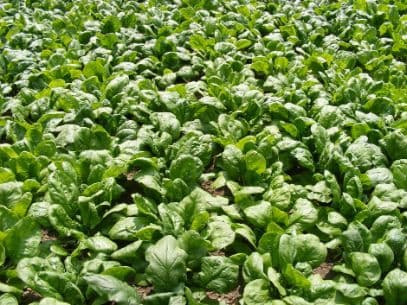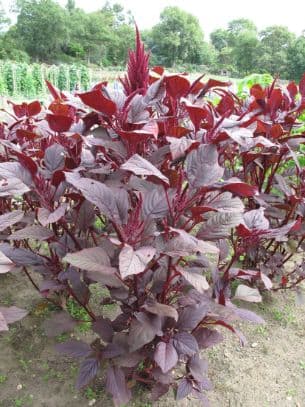Spinach Spinacia oleracea 'Emilia'

ABOUT
Spinach 'Emilia' is a leafy green plant characterized by its rich, deep green foliage which forms a rosette of leaves emanating from a central point. The leaves themselves are typically smooth-textured, with a pliable and tender quality, making them distinguishable from other varieties of spinach that may have crinkly or curly leaves. Its leaves are broad and spade-shaped, with a slightly pointed tip and attached to slender stems which hold them upright and away from the soil surface. The plant has a robust and bushy appearance, often giving it a lush, dense look. Spinach 'Emilia' can produce delicate, inconspicuous flowers that might be overlooked in favor of its edible leaves. These small, yellow-green flowers are an indication the plant is transitioning to its bolting phase, at which point the leaves may take on a more bitter flavor. The overall aesthetic of Spinach 'Emilia' is one of vitality and verdant splendor, often associated with a healthy and thriving vegetable garden.
About this plant
 Names
NamesFamily
Amaranthaceae.
Synonyms
Spinach, Smooth-leafed Spinach, Savoy Spinach, Baby Spinach.
Common names
Spinacia oleracea 'Emilia'.
 Toxicity
ToxicityTo humans
Spinacia oleracea 'Emilia' is commonly known as spinach. Spinach is not toxic to humans and is widely consumed as a leafy green vegetable. It is rich in vitamins and minerals and is considered healthy when consumed as part of a balanced diet. However, spinach contains oxalates, which can contribute to kidney stone formation in susceptible individuals if consumed in large quantities. People with kidney problems or those prone to oxalate-type kidney stones should moderate their intake of spinach.
To pets
Spinacia oleracea 'Emilia', commonly known as spinach, is not generally considered toxic to pets, including dogs and cats. However, similar to humans, spinach contains oxalates, which can lead to health issues in pets if consumed in large amounts. These issues may include kidney damage or urinary tract problems. It is generally advisable to feed pets spinach in moderation and to consult with a veterinarian before introducing significant amounts of spinach into a pet's diet, especially for animals with known health issues.
 Characteristics
CharacteristicsLife cycle
Annuals
Foliage type
Deciduous
Color of leaves
Green
Height
1-1 feet (30-30 cm)
Spread
1 feet (30 cm)
Plant type
Herb
Hardiness zones
2-11
Native area
Southwest Asia
Benefits
 General Benefits
General Benefits- High nutritional value: Rich in vitamins and minerals such as vitamin A, vitamin K, iron, and calcium.
- Easy to grow: Suitable for kitchen gardens and can thrive in various climates and soils.
- Quick harvest: Ready to pick just a few weeks after planting, providing a rapid yield.
- Continuous harvest: Can be harvested multiple times since it grows back after cutting.
- Low calorie: Ideal for weight management and low-calorie diets.
- Local cuisine: Widely used in a variety of culinary traditions and recipes.
- Extensive culinary uses: Can be eaten raw in salads or cooked in dishes like soups and pastas.
- Garden aesthetic: Offers bright green foliage that can enhance garden appearance.
- Companion planting: Compatible with many plants and can help deter pests from other crops.
- Seasonal flexibility: Can be planted in early spring and late summer for extended growing seasons.
 Medical Properties
Medical Properties- Rich in vitamins and minerals: Spinach is a substantial source of vitamins A, C, and K, as well as minerals like iron and calcium.
- Antioxidant content: Spinach contains antioxidants such as lutein, zeaxanthin, and quercetin which may support eye health and reduce oxidative stress.
- Inflammation reduction: Compounds in spinach, like flavonoids and carotenoids, might help to reduce inflammation in the body.
- Bone health support: Vitamin K present in spinach is important for maintaining bone health and strength.
- Blood pressure regulation: The high potassium content in spinach may help with maintaining healthy blood pressure levels.
- Supports digestive health: Spinach is high in fiber, which can aid in digestion and prevent constipation.
 Air-purifying Qualities
Air-purifying QualitiesThis plant is not specifically known for air purifying qualities.
 Other Uses
Other Uses- Companion Planting: Spinach can be used in a garden as a companion plant to help deter pests from more vulnerable plants, like strawberries, because its dense growth can create a microclimate that less favorable for pests.
- Natural Dye: The leaves of spinach can be boiled to extract a green pigment that can be used as a natural dye for fabrics or in arts and crafts.
- Plant Food: Spinach, being high in nitrogen and other nutrients, can be composted and then used as a natural fertilizer to enrich garden soil.
- Mulch Material: Dried spinach plants can be used as a mulch in gardens to help retain soil moisture, regulate temperature, and suppress weeds.
- Livestock Feed: Leftover and unmarketable spinach can be used as feed for various livestock due to its high nutrient content, particularly for rabbits and poultry.
- Aquatic Plant Fertilizer: Spinach can be used in an aquarium as a decomposing supplement to feed aquatic plants, as it slowly releases nutrients into the water.
- Educational Tool: Spinach can be used in educational settings, such as schools and workshops, to teach children and adults about plant biology and gardening.
- Plant-based Ink: The juice of spinach leaves can be used to make a simple plant-based ink for writing or drawing.
- Photography Backdrops: Large, flat spinach leaves can serve as natural backdrops for photographing smaller items, providing a fresh green contrast.
- Craft Projects: Spinach leaves can be pressed and dried to be used in craft projects, such as creating natural collages or botanical art pieces.
Interesting Facts
 Feng Shui
Feng ShuiSpinach is not used in Feng Shui practice.
 Zodiac Sign Compitability
Zodiac Sign CompitabilitySpinach is not used in astrology practice.
 Plant Symbolism
Plant Symbolism- Strength and Vitality: Spinach, including the variety 'Emilia', symbolizes strength and vitality because of its high nutritional content, particularly iron, which is associated with energy and good health.
- Growth and Prosperity: Its lush green leaves and rapid growth rate make spinach a representation of prosperity and the flourishing of ideas or projects.
- Resilience: Spinach is a cool-weather crop with the ability to withstand frost and some harsh conditions, thus symbolizing resilience and the capacity to overcome challenges.
- Healing: Known for its medicinal properties since ancient times, spinach symbolizes healing and restoration of the body due to its rich nutrients and antioxidants.
 Water
WaterFor 'Emilia' spinach, which is Spinacia oleracea 'Emilia', water the plant deeply once or twice a week, ensuring the soil is moist but not waterlogged. Aim for about 1 inch of water per week, which can be approximately 0.6 gallons per 10 square feet of soil. Increase frequency during dry spells or high temperatures and decrease if rainfall is sufficient. The best way to water spinach is by using a soaker hose or drip irrigation to target the roots directly and minimize leaf moisture, which can lead to disease.
 Light
Light'Emilia' spinach thrives best in full to partial sunlight. The ideal location would be a spot that receives at least 6 hours of direct sunlight daily, but it can also tolerate some shade, especially in hotter climates. Avoid excessively dark or heavily shaded areas, as this might stunt growth and reduce yield.
 Temperature
Temperature'Emilia' spinach prefers cool temperatures and can withstand a light frost. The ideal temperature range for growing 'Emilia' spinach is between 50°F and 75°F. It can survive minimum temperatures down to 20°F for short periods and maximum temperatures of about 85°F before it starts to bolt.
 Pruning
PruningPruning of 'Emilia' spinach is generally not necessary as it is grown for its leaves and harvested before it bolts (goes to seed). However, you should remove any damaged or yellowed leaves to promote healthy growth and reduce the risk of disease. Harvesting can be done continuously as needed, starting with the outer leaves allowing the center leaves to continue to grow.
 Cleaning
CleaningAs needed
 Soil
SoilFor Spinach 'Emilia,' the ideal soil mix is well-draining with plenty of organic matter such as compost or well-rotted manure. The soil should be kept consistently moist and rich in nitrogen. A slightly acidic to neutral pH between 6.0 and 7.0 is best.
 Repotting
RepottingSpinach 'Emilia' is a fast-growing annual plant and typically does not require repotting as it is usually grown directly in the garden soil or in large containers for the duration of its growing season.
 Humidity & Misting
Humidity & MistingSpinach 'Emilia' tolerates a wide range of humidity levels but thrives best in moderate conditions. Extreme humidity is not necessary for its growth, thus ambient outdoor humidity is sufficient.
 Suitable locations
Suitable locationsIndoor
Provide bright light, cool temperatures, and regular water.
Outdoor
Place in full sun to partial shade and water regularly.
Hardiness zone
2-11 USDA
 Life cycle
Life cycleSpinach 'Emilia' begins its life cycle with seed germination, which requires cool temperatures and moist soil conditions. The seedlings emerge and produce a rosette of leaves during their vegetative stage. As the plant matures, it develops a sturdy stem and produces a cluster of leaves that are harvested before the flowering stage. Upon reaching maturity, it sends up a flowering stalk, where small yellow-green flowers are produced and subsequently pollinate to produce seeds. After flowering, the plant sets seed and eventually completes its cycle by senescing, at which point it dies, having produced seeds for the next generation. This spinach variety is typically an annual, completing its life cycle within one growing season.
 Propogation
PropogationPropogation time
Spring to early summer
Spinach (Spinacia oleracea 'Emilia') is typically propagated by seeds. The most popular method involves sowing the seeds directly into the garden. Propagation time should ideally be in the early spring as soon as the soil can be worked, or during the fall for a winter crop in milder climates. To propagate, prepare the soil with adequate organic matter, and sow the seeds about 1/2 inch deep. Seeds should be spaced around 2 to 3 inches apart, and rows should be about 12 to 18 inches apart to allow for growth and air circulation. Once the seedlings emerge, thin them out to about 6 inches apart. Spinach prefers cooler weather, so for a continuous harvest, successional plantings every couple of weeks is advisable.




